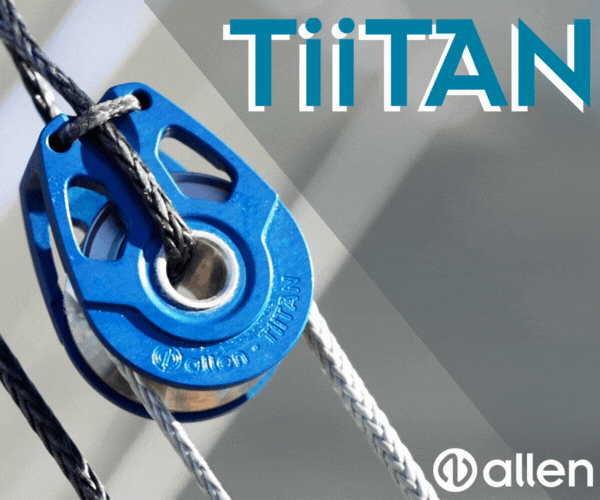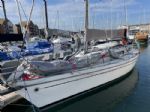








-(1)-202408140552.gif)


| Laser 140101 Tynemouth |
 |
| Laser 28 - Excellent example of this great design Hamble le rice |
 |
| Rossiter Pintail Mortagne sur Gironde, near Bordeaux |
 |
List classes of boat for sale |
Best rope for main halyard |
Post Reply 
|
Page <12345 6> |
| Author | |
Medway Maniac 
Really should get out more 
Joined: 13 May 05 Location: United Kingdom Online Status: Offline Posts: 2788 |
 Post Options Post Options
 Quote Quote  Reply Reply
 Topic: Best rope for main halyard Topic: Best rope for main halyardPosted: 18 Mar 09 at 11:39am |
|
|
 |
|
Jamesd 
Far too distracted from work 
Joined: 01 Feb 08 Online Status: Offline Posts: 377 |
 Post Options Post Options
 Quote Quote  Reply Reply
 Posted: 18 Mar 09 at 11:11am Posted: 18 Mar 09 at 11:11am |
|
all this is confusing and im struggling to understand. I mean Peaky, since when has a halyard been used in compression? rope would buckle almost immediately in compression. i know, you mean the mast has compressive forces. with 100kN acting downwards on a mast from the sail you then have 50kN running down the mast in the halyard (if 2:1) therefore to resist the force the deck must produce a reaction, of 150kN, or the sail and mast will come out the bottom of the boat. the mast acts as a compressive member. thats all very well and good. but what about the 50kN acting downwards at the dead end of the knot at the top of the mast, that brings the total downward force to 200kN thus the compression in the mast must be 200kN which is the same as a 1:1. the 2:1 will be easier to pull up and would require less of a reaction to hold it up there (think of a mainsheet and the difference of 1:1 and multiple purchases), but mast compression does not change. locking the sail at the top of the mast reduces the compression as you can neglect the halyard loads acting downwards and therefore a smaller reaction is needed. I think thats all right, my head is spinning to be honest. Lol ive just confused myself even more. in reality though, though the compression forces acting down do not run down the centre of the mast. they are offset (the sail at the top) causing a moment and initiating a buckle in the mast and thus the trailing edge of the mast carries compressive load and the front edge will be under tension. plus there are many many more factors to think of, such as the fact the force on the sail is a vector not just a parrallel force |
|
 |
|
Guests 
Guest Group 
|
 Post Options Post Options
 Quote Quote  Reply Reply
 Posted: 18 Mar 09 at 9:58am Posted: 18 Mar 09 at 9:58am |
|
MM is right. A cat-style halyard lock does reduce mast compression, as well as eliminate halyard stretch/slip. A 1:1 halyard has twice the compressive load of a halyard lock. A 2:1 halyard has 1.5 times the compressive load of a halyard lock, or 0.75 times the compressive load of a 1:1 system. Some of that gain will be lost due to system inefficiency, but there is still a gain. However, you do end up with another 6m of rope to stow!
Edited by Peaky |
|
 |
|
Medway Maniac 
Really should get out more 
Joined: 13 May 05 Location: United Kingdom Online Status: Offline Posts: 2788 |
 Post Options Post Options
 Quote Quote  Reply Reply
 Posted: 18 Mar 09 at 9:45am Posted: 18 Mar 09 at 9:45am |
|
In practice you don't get the 2:1 halyard "block -to-block" (there are no blocks, of course), and there are exposed lengths of halyard between the mast-top pulley and the sail head (I've never seen otherwise), so the halyard tension and compression remain reduced. But I think you've now got the point. |
|
 |
|
craiggo 
Really should get out more 

Joined: 01 Apr 04 Location: United Kingdom Online Status: Offline Posts: 1810 |
 Post Options Post Options
 Quote Quote  Reply Reply
 Posted: 18 Mar 09 at 8:21am Posted: 18 Mar 09 at 8:21am |
|
Yes & No.
Moving the halyard cleat up the mast reduces the exposed length of mast over which the force is acting. However multiple purchases will not reduce the overall force between the head of the sail and the block at the top of the mast, they simply divide the force up over all the runs out of the blocks. The overall force holding the sail up is still the same. Once the blocks are all block to block you loose most, if not all of your mechanical advantage and the load on the tail of the halyard running down the mast will become almost the same as the force holding the sail up. Your theory works absolutely fine assuming that you dont pull your main all the way up, however in doing this you expose much larger lengths of halyard to stretch. |
|
 |
|
alstorer 
Really should get out more 

Joined: 02 Aug 07 Location: Cambridge Online Status: Offline Posts: 2899 |
 Post Options Post Options
 Quote Quote  Reply Reply
 Posted: 17 Mar 09 at 6:09pm Posted: 17 Mar 09 at 6:09pm |
|
If a 2:1 didn't reduce compression compared to a 1:1, it also wouldn't make it any easier to pull the sail up- the force involved, after all, comes from the same source...
|
|
|
-_
Al |
|
 |
|
Medway Maniac 
Really should get out more 
Joined: 13 May 05 Location: United Kingdom Online Status: Offline Posts: 2788 |
 Post Options Post Options
 Quote Quote  Reply Reply
 Posted: 17 Mar 09 at 5:48pm Posted: 17 Mar 09 at 5:48pm |
|
But with a 1:1 halyard, the tension in the halyard running down the mast is by definition the same as the tension in the bit of halyard tied to the sail-head (less any minimal losses due to friction in the pulley). You will therefore have 2xT compressing the mast at least between the mast-head pulley and the gooseneck area, assuming the cleat is at or below the gooseneck. Now, move your cleat up to the masthead (to effectively provide a halyard lock) and there's only 1xT acting between the mast-head and gooseneck area, namely that efected by the sail (we're neglecting standing rigging loads etc. here, obviously). Put a 2:1 on the sail head and dead-end it at the mast-head and we'll have a lower tension in the halyard. Thus the compressive force will be that produced by the sail plus the lower tension in the 2:1'd halyard, hence lower compression than with a simple 1:1 halyard. |
|
 |
|
craiggo 
Really should get out more 

Joined: 01 Apr 04 Location: United Kingdom Online Status: Offline Posts: 1810 |
 Post Options Post Options
 Quote Quote  Reply Reply
 Posted: 17 Mar 09 at 5:21pm Posted: 17 Mar 09 at 5:21pm |
|
Medway, referring now to your latest question, the overall compression in the mast would increase if you ran the halyard back up to a multiple purchase on the mast because you have reduced the amount off effort required to install tension in the halyard.
I can sort of see where you are going on this therefore I will provide my answer. Having a halyard which runs down the length of the mast will lead to compressive force acting on the mast, when no other controls are applied, however this force will be small when compared to cunningham and kicker loads applied when sailing. Changing from a 1:1 to 2:1 halyard will not change the compression forces acting on the mast, as ultimately the fully tensioned halyard will run down the mast, and once the sail is fully up the mechanical advantage is all gone, you have the same force tension in the line as a 1:1. Obviously the luff curve on many classes is cut to allow for a given amount of mast compression caused by halyard tension. To remove the static mast compression from the equation the sails can be shackled to the top of the mast or use a halyard lock. But as said above the compressive loads will ultimately be driven by cunningham and kicker controls not halyard. Aaarrgggg my head hurts. Back to designing aircraft I suppose! |
|
 |
|
craiggo 
Really should get out more 

Joined: 01 Apr 04 Location: United Kingdom Online Status: Offline Posts: 1810 |
 Post Options Post Options
 Quote Quote  Reply Reply
 Posted: 17 Mar 09 at 5:12pm Posted: 17 Mar 09 at 5:12pm |
|
Medway, sorry to go back to what I was saying before.
Your analogy that an angel is holding the head of the sail up, and then you provide a pulley is all very well and good when you assume that the other end of the line is terminated at a rigid and isolated point with no degrees of freedom. In the real case of a halyard the other end is terminated on the mast tip, and usually on the same pivot/pin that the tail runs over, and therefore it is all tied into the system which has degrees of freedom and is not ideally constrained. As such regardless of how many blocks you have at the top of the mast ultimatly the total compressive forces are being reacted by the mast and the rigging, they are not miracleously halved by a pulley. The load transmitted between the bulkhead and the boom in the kicker arrangement is not reduced by the purchases, simply the effort needed to increase the force is reduced. |
|
 |
|
Medway Maniac 
Really should get out more 
Joined: 13 May 05 Location: United Kingdom Online Status: Offline Posts: 2788 |
 Post Options Post Options
 Quote Quote  Reply Reply
 Posted: 17 Mar 09 at 3:43pm Posted: 17 Mar 09 at 3:43pm |
|
Alright guys, here's another exercise to free up your thinking. If I put a multi-block at the top and bottom of the mast, and instead of cleating the halyard at the foot of the mast as usual, I ran the halyard betwen the multiblocks N times then cleated it. Do you think that might increase compression on the mast? Now go back to our earlier examples and have another think. The mast lock means there need be substantially no tension in the run of halyard coming down the mast from the mast lock, remember... |
|
 |
|
Post Reply 
|
Page <12345 6> |
| Forum Jump | Forum Permissions  You cannot post new topics in this forum You cannot reply to topics in this forum You cannot delete your posts in this forum You cannot edit your posts in this forum You cannot create polls in this forum You cannot vote in polls in this forum |
Copyright ©2001-2010 Web Wiz
Change your personal settings, or read our privacy policy












 Printable Version
Printable Version Delicious
Delicious Digg
Digg Facebook
Facebook Furl
Furl Google
Google MySpace
MySpace Newsvine
Newsvine reddit
reddit StumbleUpon
StumbleUpon Twitter
Twitter Windows Live
Windows Live Yahoo Bookmarks
Yahoo Bookmarks Topic Options
Topic Options